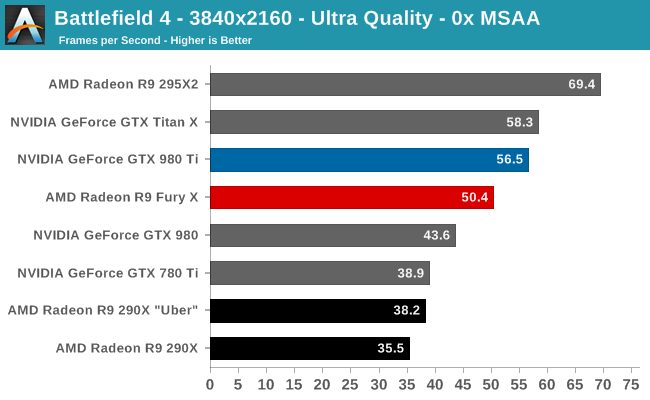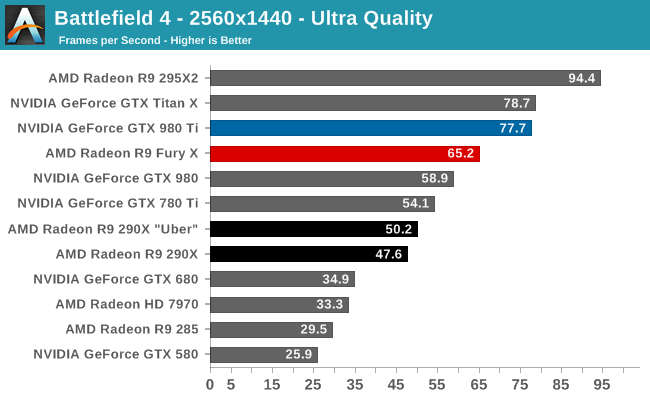The AMD Radeon R9 Fury X Review: Aiming For the Top
by Ryan Smith on July 2, 2015 11:15 AM ESTBattlefield 4
Kicking off our benchmark suite is Battlefield 4, DICE’s 2013 multiplayer military shooter. After a rocky start, Battlefield 4 has since become a challenging game in its own right and a showcase title for low-level graphics APIs. As these benchmarks are from single player mode, based on our experiences our rule of thumb here is that multiplayer framerates will dip to half our single player framerates, which means a card needs to be able to average at least 60fps if it’s to be able to hold up in multiplayer.



As we briefly mentioned in our testing notes, our Battlefield 4 testing has been slightly modified as of this review to accommodate the changes in how AMD is supporting Mantle. This benchmark still defaults to Mantle for GCN 1.0 and GCN 1.1 cards (7970, 290X), but we’re using Direct3D for GCN 1.2 cards like the R9 Fury X. This is due to the lack of Mantle driver optimizations on AMD’s part, and as a result the R9 Fury X sees poorer performance here, especially at 2560x1440 (65.2fps vs. 54.3fps).
In any case, regardless of the renderer you pick, our first test does not go especially well for AMD and the R9 Fury X. The R9 Fury X does not take the lead at any resolution, and in fact this is one of the worse games for the card. At 4K AMD trails by 8-10%, and at 1440p that’s 16%. In fact the latter is closer to the GTX 980 than it is the GTX 980 Ti. Even with the significant performance improvement from the R9 Fury X, it’s not enough to catch up to NVIDIA here.
Meanwhile the performance improvement over the R9 290X “Uber” stands at between 23% and 32% depending on the resolution. AMD not only scales better than NVIDIA with higher resolutions, but R9 Fury X is scaling better than R9 290X as well.










458 Comments
View All Comments
chizow - Monday, July 6, 2015 - link
Oh, and also forgot his biggest mistake was vastly overpaying for ATI, leading both companies on this downward spiral of crippling debt and unrealized potential.chizow - Monday, July 6, 2015 - link
Uh...Bulldozer happened on Ruiz's watch, and he also wasn't able to capitalize on K8's early performance leadership. Beyond that he orchestrated the sale of their fabs to ATIC culminating in the usurious take or pay WSA with GloFo that still cripples them to this day. But of course, it was no surprise why he did this, he traded AMD's fabs for a position as GloFo's CEO which he was forced to resign from in shame due to insider trading allegations. Yep, Ruiz was truly a crook but AMD fanboys love to throw stones at Huang. :Dtipoo - Thursday, July 2, 2015 - link
Nooo please put it back, it was so much better with Anandtech referring to AMD as the taint :PHOOfan 1 - Thursday, July 2, 2015 - link
At least he didn't spell it "perianal"Wreckage - Thursday, July 2, 2015 - link
It's silly to paint AMD as the underdog. It was not that long ago that they were able to buy ATI (a company that was bigger than NVIDIA). I remember at the time a lot of people were saying that NVIDIA was doomed and could never stand up to the might of a combined AMD + ATI. AMD is not the underdog, AMD got beat by the underdog.Drumsticks - Thursday, July 2, 2015 - link
I mean, AMD has a market cap of ~2B, compared to 11B of Nvidia and ~140B of Intel. They also have only ~25% of the dGPU market I believe. While I don't know a lot about stocks and I'm sure this doesn't tell the whole story, I'm not sure you could ever sell Nvidia as the underdog here.Kjella - Thursday, July 2, 2015 - link
Sorry but that is plain wrong as nVidia wasn't just bigger than ATI, they were bigger than AMD. Their market cap in Q2 2006 was $9.06 billion, on the purchase date AMD was worth $8.84 billion and ATI $4.2 billion. It took a massive cash/stock deal worth $5.6 billion to buy ATI, including over $2 billion in loans. AMD stretched to the limit to make this happen, three days later Intel introduced the Core 2 processor and it all went downhill from there as AMD couldn't invest more and struggled to pay interest on falling sales. And AMD made an enemy of nVidia, which Intel could use to boot nVidia out of the chipset/integrated graphics market by not licensing QPI/DMI with nVidia having nowhere to go. It cost them $1.5 billion, but Intel has made back that several times over since.kspirit - Thursday, July 2, 2015 - link
That was pretty savage of Intel, TBH. I'm impressed.Iketh - Monday, July 6, 2015 - link
or you could say AMD purposely finalized the purchase just before Core2 was introduced... after Core2, the purchase would have been impossibleWreckage - Thursday, July 2, 2015 - link
http://money.cnn.com/2006/07/24/technology/nvidia_...AMD was worth $8.5B and ATI was worth $5B at the time of the merger making them worth about twice what NVIDIA was worth at the time ($7B)
In 2004 NVIDIA had a market cap of $2.4B and ATI was at $4.3B nearly twice.
http://www.tomshardware.com/news/nvidias-market-sh...
NVIDIA was the underdog until the combined AMD+ATI collapsed and lost most of their value. They are Goliath brought down by David.